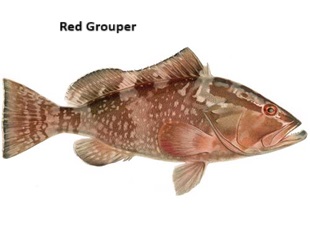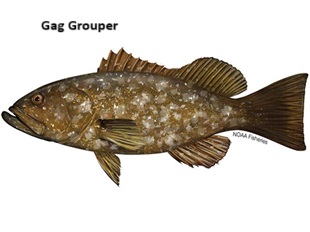|
Groupers are teleosts, typically
having a stout body
 and
a large mouth. They are not built for long-distance fast swimming.
They can be quite large, and lengths over a meter and weights up to
100 kg are not uncommon, though obviously in such a large group
species vary considerably. They swallow prey rather than biting
pieces off it. They do not have many teeth on the edges of their
jaws, but they have heavy crushing tooth plates inside the pharynx.
They habitually eat fish, octopus, crab, and lobster. They lie in
wait, rather than chasing in open water. According to the film-maker
Graham Ferreira, there is at least one record, from Mozambique, of a
human being killed by one of these fish. and
a large mouth. They are not built for long-distance fast swimming.
They can be quite large, and lengths over a meter and weights up to
100 kg are not uncommon, though obviously in such a large group
species vary considerably. They swallow prey rather than biting
pieces off it. They do not have many teeth on the edges of their
jaws, but they have heavy crushing tooth plates inside the pharynx.
They habitually eat fish, octopus, crab, and lobster. They lie in
wait, rather than chasing in open water. According to the film-maker
Graham Ferreira, there is at least one record, from Mozambique, of a
human being killed by one of these fish.
Their mouth and gills form a powerful sucking system that sucks
their prey in from a distance. They also use their mouth to dig into
sand to form their shelters under big rocks, jetting it out through
their gills. Their gill muscles are so powerful that it is nearly
impossible to pull them out of their cave if they feel attacked and
extend those muscles to lock themselves in.
There is some research indicating that roving coral groupers (Plectropomus
pessuliferus) sometimes cooperate with giant morays in hunting.
The gag grouper (Mycteroperca
microlepis) is a drab,
 mottled
gray fish lacking the distinguishing features of other groupers. It
has a pattern of markings which resemble the box-shaped spots of the
black grouper. It lacks the streamer-points on the tail fin that
scamp (Mycteroperca phenax) and yellowmouth grouper (M.
interstitialis) have and lacks yellow coloration around the mouth. mottled
gray fish lacking the distinguishing features of other groupers. It
has a pattern of markings which resemble the box-shaped spots of the
black grouper. It lacks the streamer-points on the tail fin that
scamp (Mycteroperca phenax) and yellowmouth grouper (M.
interstitialis) have and lacks yellow coloration around the mouth.
Ten- to twenty-pound (5 to 10 kg) fish are common. The world record
is 80 lb 6 oz (36.45 kg). The gag grouper is a bottomfeeder and is
often caught by fishermen seeking bottom-dwelling species such as
snappers. It has flaky white meat that is considered quite
delicious.
Members of this species are known to be protogynous hermaphrodites,
schooling in harems with the most aggressive and largest females
shifting sex to male, probably as a result of behavioral triggers,
when there is no male available. Commercial and sport fishing have
created tremendous selective pressures against the largest animals,
typically male, restricting the reproductive capacity of the entire
breeding population. Recently, a small closure in the Gulf of Mexico
was established to provide this and other species a refuge from
commercial fishing pressure, however, this data is highly in dispute
and is currently being challenged for inaccuracies. They are found
in areas of hard or consolidated substrate, and use structural
features such as ledges, rocks, and coral reefs ( as well as
artificial reefs like wrecks and sunken barges) as their habitat.
The Atlantic goliath grouper or
itajara (Epinephelus itajara)
 is
a large saltwater fish of the grouper family. It is commonly known
as the jewfish; however, in 2001 the Committee on Names of Fishes, a
seven-member joint committee of the American Society of
Ichthyologists and Herpetologists and the American Fisheries Society
made the decision to change the name to "Goliath Grouper". Genus
Epinephelus also includes the Pacific goliath grouper. is
a large saltwater fish of the grouper family. It is commonly known
as the jewfish; however, in 2001 the Committee on Names of Fishes, a
seven-member joint committee of the American Society of
Ichthyologists and Herpetologists and the American Fisheries Society
made the decision to change the name to "Goliath Grouper". Genus
Epinephelus also includes the Pacific goliath grouper.
The goliath grouper is found primarily in shallow tropical waters
among coral and artificial reefs at depths of up to 165 feet (50 m).
Their range includes the Florida Keys, the Bahamas, most of the
Caribbean, and practically all of the Brazilian coast, where they
are known as mero. On some occasions it is caught in New England off
Maine and Massachusetts but it is not that common. In the eastern
Atlantic Ocean, it occurs from Congo to Senegal.
Young grouper may live in brackish estuaries, canals, and mangrove
swamps, unusual behavior among grouper.
Atlantic goliath grouper
They may reach extremely large sizes, growing to lengths of 8.2 feet
(2.5 m) and can weigh as much as 800 pounds (363 kg). In Florida,
the largest hook and line captured specimen weighed 680 pounds (309
kg). They are usually around 400 lb when mature. Considered of fine
food quality, the goliath grouper were a highly sought after quarry
for fishermen of all types. The goliath grouper's inquisitive and
generally fearless nature make it a relatively easy prey for spear
fishermen. They also tend to spawn in large aggregations returning
like clockwork to the same locations making them particularly
vulnerable to mass harvesting. Until a harvest ban was placed on the
species, the species was in rapid decline. The goliath grouper is
entirely protected from harvest and is recognized as a critically
endangered species by the World Conservation Union (IUCN). The U.S.
began protection in 1990 and the Caribbean in 1993. The species'
population has been recovering since the ban, however with the
fish's slow growth rate it will take some time for populations to
return to their previous levels.
Information courtesy of
Wikipedia
|